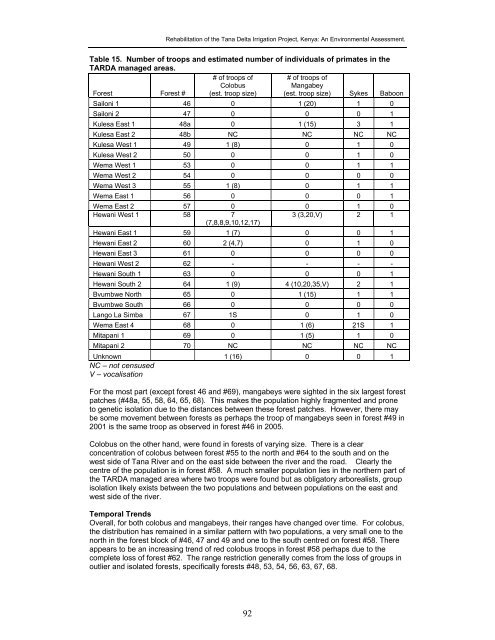Tana Delta Irrigation Project, Kenya: An Environmental Assessment
Tana Delta Irrigation Project, Kenya: An Environmental Assessment
Tana Delta Irrigation Project, Kenya: An Environmental Assessment
You also want an ePaper? Increase the reach of your titles
YUMPU automatically turns print PDFs into web optimized ePapers that Google loves.
Rehabilitation of the <strong>Tana</strong> <strong>Delta</strong> <strong>Irrigation</strong> <strong>Project</strong>, <strong>Kenya</strong>: <strong>An</strong> <strong>Environmental</strong> <strong>Assessment</strong>.<br />
Table 15. Number of troops and estimated number of individuals of primates in the<br />
TARDA managed areas.<br />
Forest Forest #<br />
# of troops of<br />
Colobus<br />
(est. troop size)<br />
# of troops of<br />
Mangabey<br />
(est. troop size) Sykes Baboon<br />
Sailoni 1 46 0 1 (20) 1 0<br />
Sailoni 2 47 0 0 0 1<br />
Kulesa East 1 48a 0 1 (15) 3 1<br />
Kulesa East 2 48b NC NC NC NC<br />
Kulesa West 1 49 1 (8) 0 1 0<br />
Kulesa West 2 50 0 0 1 0<br />
Wema West 1 53 0 0 1 1<br />
Wema West 2 54 0 0 0 0<br />
Wema West 3 55 1 (8) 0 1 1<br />
Wema East 1 56 0 0 0 1<br />
Wema East 2 57 0 0 1 0<br />
Hewani West 1 58 7<br />
3 (3,20,V) 2 1<br />
(7,8,8,9,10,12,17)<br />
Hewani East 1 59 1 (7) 0 0 1<br />
Hewani East 2 60 2 (4,7) 0 1 0<br />
Hewani East 3 61 0 0 0 0<br />
Hewani West 2 62 - - - -<br />
Hewani South 1 63 0 0 0 1<br />
Hewani South 2 64 1 (9) 4 (10,20,35,V) 2 1<br />
Bvumbwe North 65 0 1 (15) 1 1<br />
Bvumbwe South 66 0 0 0 0<br />
Lango La Simba 67 1S 0 1 0<br />
Wema East 4 68 0 1 (6) 21S 1<br />
Mitapani 1 69 0 1 (5) 1 0<br />
Mitapani 2 70 NC NC NC NC<br />
Unknown 1 (16) 0 0 1<br />
NC – not censused<br />
V – vocalisation<br />
For the most part (except forest 46 and #69), mangabeys were sighted in the six largest forest<br />
patches (#48a, 55, 58, 64, 65, 68). This makes the population highly fragmented and prone<br />
to genetic isolation due to the distances between these forest patches. However, there may<br />
be some movement between forests as perhaps the troop of mangabeys seen in forest #49 in<br />
2001 is the same troop as observed in forest #46 in 2005.<br />
Colobus on the other hand, were found in forests of varying size. There is a clear<br />
concentration of colobus between forest #55 to the north and #64 to the south and on the<br />
west side of <strong>Tana</strong> River and on the east side between the river and the road. Clearly the<br />
centre of the population is in forest #58. A much smaller population lies in the northern part of<br />
the TARDA managed area where two troops were found but as obligatory arborealists, group<br />
isolation likely exists between the two populations and between populations on the east and<br />
west side of the river.<br />
Temporal Trends<br />
Overall, for both colobus and mangabeys, their ranges have changed over time. For colobus,<br />
the distribution has remained in a similar pattern with two populations, a very small one to the<br />
north in the forest block of #46, 47 and 49 and one to the south centred on forest #58. There<br />
appears to be an increasing trend of red colobus troops in forest #58 perhaps due to the<br />
complete loss of forest #62. The range restriction generally comes from the loss of groups in<br />
outlier and isolated forests, specifically forests #48, 53, 54, 56, 63, 67, 68.<br />
92

















